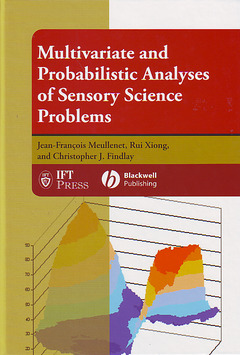Multivariate & probabilistic analyses of sensory science problems
Auteur : MEULLENET Jean-François

Introduction.
Chapter 1: A description of sample datasets.
1.1. White Corn Tortilla Chips.
1.2. Muscadine Grape Juices.
1.3. Fried Mozzarella Cheese Stick Appetizers.
1.4. Datasets for panellist and panel performance evaluation.
1.5. References.
Chapter 2: Panelist and Panel Performance a Multivariate Experience.
2.1. The multivariate nature of sensory evaluation.
2.2. Univariate approaches to panelist assessment.
2.3. Multivariate techniques for panelist performance.
2.4. Panel Evaluation through Multivariate Techniques.
2.5. Conclusions.
2.6. References.
Chapter 3: A Non Technical Description of Preference Mapping.
3.1. Introduction.
3.2. Internal preference mapping.
3.3. External Preference Mapping (PREFMAP).
3.4. Conclusions.
3.5. References.
Chapter 4: Deterministic extensions to preference mapping techniques.
4.1. Introduction.
4.2. Application and models available.
4.3. Conclusions.
4.4 References.
Chapter 5: Multidimensional scaling and unfolding and the application of probabilistic unfolding to model preference data.
5.1 Introduction.
5.2. Multidimensional Scaling (MDS) and Unfolding.
5.3. Probabilistic Approach to Unfolding and Identifying the Drivers of Liking®.
5.4. Examples.
5.5. References.
Chapter 6: Consumer Segmentation Techniques.
6.1. Introduction.
6.2. Methods Available.
6.3. Segmentation Methods using Hierarchical Cluster Analysis.
6.4. References.
Chapter 7: Ordinal Logistic Regression Models in Consumer Research.
7.1. Introduction.
7.2. Limitations of ordinary least square regression.
7.3. Odds, odds ratio and logit.
7.4. Binary logistic regression.
7.5. Multinomial logistic regression.
7.6. Ordinal logistic regression.
7.7. Conclusions.
7.8. References.
Chapter 8: Risk assessment in sensory and consumer science.
8.1. Introduction.
8.2. Concepts of Quantitative Risk Assessment.
8.3. A Case Study: Cheese Sticks Appetizers8.4. Conclusions.
8.5. References.
Chapter 9: Application of MARS to Preference Mapping.
9.1. Introduction.
9.2. MARS Basics.
9.3. Setting Control Parameters and Refining Models.
9.4. Example of application of MARS9.5. A comparison with Partial Least Squares Regression.
9.6. References.
Chapter 10: Analysis of Just About Right data.
10.1. Introduction.
10.2. Basics of Penalty Analysis.
10.3. Boot Strapping Penalty Analysis.
10.4. Use of MARS to model JAR data.
10.5. A proportional Odds/Hazards approach to diagnostic data analysis.
10.6. Use of dummy variables to model JAR data.
10.7 References.
Index
Date de parution : 07-2007
Ouvrage de 280 p.
18x25 cm


